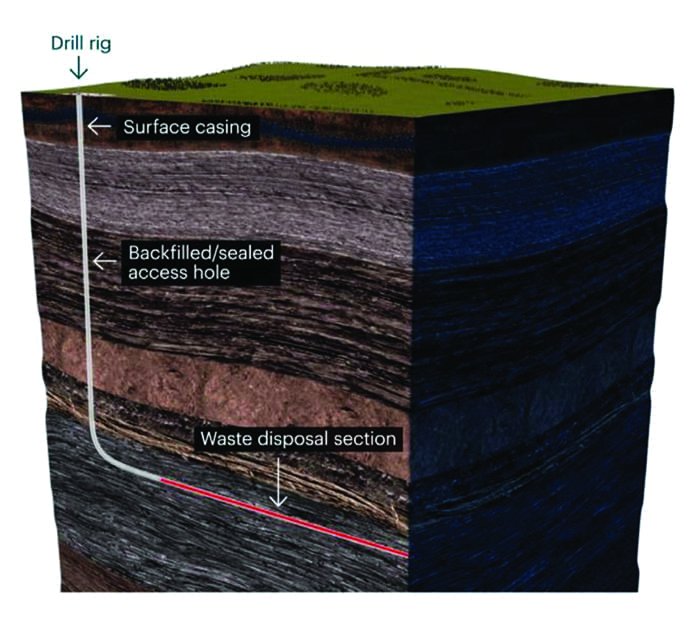Efforts to explore whether it is feasible to permanently dispose of high-level nuclear waste in deep horizontal boreholes under next-generation nuclear reactor sites got a boost in late April as nuclear waste technology firm Deep Isolation signed its first contract with industry.
Under the contract with independent nonprofit organization Electric Power Research Institute (EPRI), the Berkeley, California–based company will team with EPRI researchers, Southern Co., the Nuclear Energy Institute (NEI), Auburn University, and nuclear waste management consultancy J Kessler and Associates to assess how Deep Isolation’s horizontal borehole disposal solution could contribute to siting of advanced nuclear energy systems. Specifically, the team plans to explore physical site characteristics, disposal operations, safety performance analysis, and regulatory and licensing considerations. As crucially, they will also outline an approach to understanding and building public support.
A Demonstrated Solution to an Enduring Problem
That U.S. industry is leading the study is notable because, though legally obligated to dispose of highly radioactive spent nuclear fuel (SNF) by the Nuclear Waste Policy Act (NWPA) of 1982, the Department of Energy’s (DOE’s) efforts to revive the Yucca Mountain deep geologic repository in Nevada hang in limbo, stymied by decades of political vacillation, and fierce public pushback (for a comprehensive history, see “A Break in the Nuclear Waste Impasse?” in POWER’s March 2018 issue).
Industry trade group NEI in May pointed out that taxpayers continue to dole out $800 million annually because the federal government fails to meet its disposal mandates. Meanwhile, the inventory of SNF that is being stored temporarily in spent fuel pools and dry storage systems at 121 locations across 39 states has surged relentlessly upward to more than 80,000 metric tons. (NEI notes in an October 2019 fact sheet, however, that though the number “may sound like a lot,” all used fuel produced since the late 1950s “would cover a football field to a height of less than 10 yards.”)
The NEI has urged the U.S. government to establish a sustainable national program and dedicated funding to permanently dispose of used fuel, but it is also spearheading industry approaches to facilitate near-term solutions, such as for potential consolidated interim storage facilities. Action on used fuel disposal is growing more urgent, it says, because developers are racing to commercialize next-generation nuclear technologies.
Though some new designs like fast reactors and molten salt reactors promise to consume and even run on used nuclear fuel in the future, small modular reactors, microreactors, and advanced non-light-water reactors will benefit from expanded waste management options. The study with Deep Isolation could be helpful to industry and the public in understanding the uses of horizontal deep borehole disposal as an alternative. EPRI Senior Technical Executive of Advanced Nuclear Technology Andrew Sowder noted in April, “We want to equip next-generation reactors with a plan for handling nuclear waste from the beginning, and the collaboration this project offers is a potential path.”
Decentralized Burial
The non-government contract is also significant for Deep Isolation, a company founded in 2016 by a team of scientists, environmentalists, and entrepreneurs who were committed to creating a safe and cost-effective solution for the permanent disposal of nuclear waste. So far, it has raised more than $14 million, garnered a noteworthy team of technical advisers, including Bechtel, NAC International, and Schlumberger, published three technical papers, and collected “half a dozen letters of intent from future customers.”
 |
|
1. Deep Isolation’s solution to the long-pervading issue of nuclear waste disposal is to lower nuclear waste canisters in an end-to-end configuration into encased horizontal holes that have been drilled about 1 mile deep under or near a proposed nuclear generating site, or in multiple drillholes at central or regional locations. When ready for permanent sealing, the vertical portion of the casing is removed and backfilled with rock, bentonite, and other materials. Courtesy: Deep Isolation |
Deep Isolation’s solution essentially proposes placing spent fuel (in fuel assemblies) and other waste into the company’s 14-foot-long corrosion-resistant canisters, and then pushing them into carbon steel–encased horizontal drillholes at depths of 1 mile or more underground (Figure 1) using drill pipe, coiled tubing, or wireline with tractors. The process can be reversed, which is important, because the Nuclear Regulatory Commission (NRC) requires waste to be retrievable for a period of time. “For a Deep Isolation sealed drillhole, an expert crew could still retrieve the waste, but it would take a week or possibly longer. Doing so is sufficiently complex to offer substantial security from a terrorist attempt to retrieve the waste,” it says.
The curved drillholes will be bored using Deep Isolation directional drilling technology “in stable geological formations that have been out of contact with the biosphere for millions of years,” it explains. Drillholes are typically about 18 inches in diameter to accommodate the canister diameter, which will range from 9 to 13 inches, and they can extend horizontally for two miles in sedimentary, igneous, or metamorphic host rocks. That effort is made possible by remarkable advances in directional drilling technology, such as for fracking (though Deep Isolation will not frack), which has made such deep horizontal drillholes “reliable and inexpensive,” it says.
Digital simulation of Deep Isolation’s nuclear waste disposal technique. Video: Deep Isolation/YouTube
Deep Isolation’s first-of-a-kind demonstration (video) in January 2019 to place and retrieve a prototype disposal canister from an existing deep horizontal drillhole was the company’s own initiative, backed by partnerships with industrial heavyweights. It notes, however, that the DOE had previously attempted to start a test program for defense waste that envisioned vertical boreholes drilled much deeper into crystalline basement rock, such as granite. “The founders of Deep Isolation were familiar with this program but felt that there was a great advantage to drilling into less brittle rock and taking advantage of directional drilling,” Deep Isolation says.
Government Action Needed for Progress
Time is a crucial consideration. Compared to Yucca Mountain—which would take 35 years to be ready to receive waste—regional hubs deploying Deep Isolation’s solution under an NRC interim storage license could be ready within five years, it says. Assuming a project could secure a license from the NRC, it would take just a few months to mobilize and drill the disposal drillhole. And despite the new research focus on advanced nuclear reactor siting, Deep Isolation says its technology is available now, and it could potentially deal with the nation’s entire SNF inventory: “With horizontal disposal sections [of up to 2 miles long], it would take 300 such horizontal drillholes to dispose of 80,000 tons of commercial spent nuclear fuel,” it says.
However, the solution would still be barred from accepting waste inventories unless the NWPA is amended to allow the DOE to seek licenses for alternatives—and that’s because a 1987 amendment to the law specifies Yucca Mountain as the nation’s sole repository option. So, “Rather than viewing ourselves as competitors, we view Deep Isolation’s solution as a supplementary approach for those sites and states that have suitable geology and a community that prefers local or in-state disposal,” the company says.
Though it was founded to provide solutions to the U.S. nuclear waste impasse, Deep Isolation is now also eyeing other markets. “Nations with smaller inventories of waste may find that horizontal drillhole disposal is especially cost-effective,” it says. In these countries, with the right customer and government support, the company says it could begin safely disposing of commercial waste within two to three years.
Eyeing a Global Market
The company took more concrete steps this May to establish itself in Europe, the Middle East, and Africa by publishing a white paper for policymakers to inform them of the alternative disposal method. In the paper, it notes that despite consensus that deep geological disposal is the preferred solution for the long-term disposal of nuclear waste, no countries have yet succeeded in fully implementing the approach, owing mainly to high costs and difficulty in obtaining community consent. The company’s analysis of repositories planned separately by Canada, Sweden, the UK, and the U.S. found that they would cost a combined $172 billion (in 2020 dollars)—not including the costs of interim storage—and construction could take about a decade. “The alternative, deep horizontal boreholes, can be deployed in less than a year and provide the benefits of deep geological disposal for a fraction of the cost of a mined repository,” it says.
If compared with existing temporary storage solutions such as dry cask storage or spent fuel pools, Deep Isolation would be competitive over the medium-term (after 10 to 20 years), depending on factors such as type of waste, location, and geology. “After this time, [the solution] is significantly more economical, with potentially a 50% or greater saving over 20 to 40 years,” it says. The key benefit that the company underscores is that it offers communities flexibility to shift from storage to disposal. “This change is fundamentally one about regulatory approval and community consent rather than technical implementation,” it says.
—Sonal Patel is a POWER senior associate editor (@sonalcpatel, @POWERmagazine).








